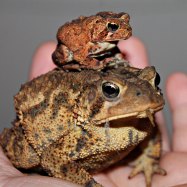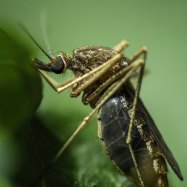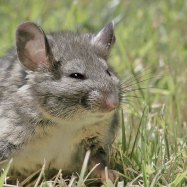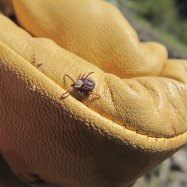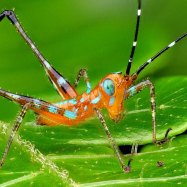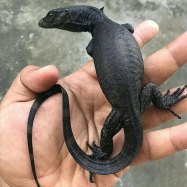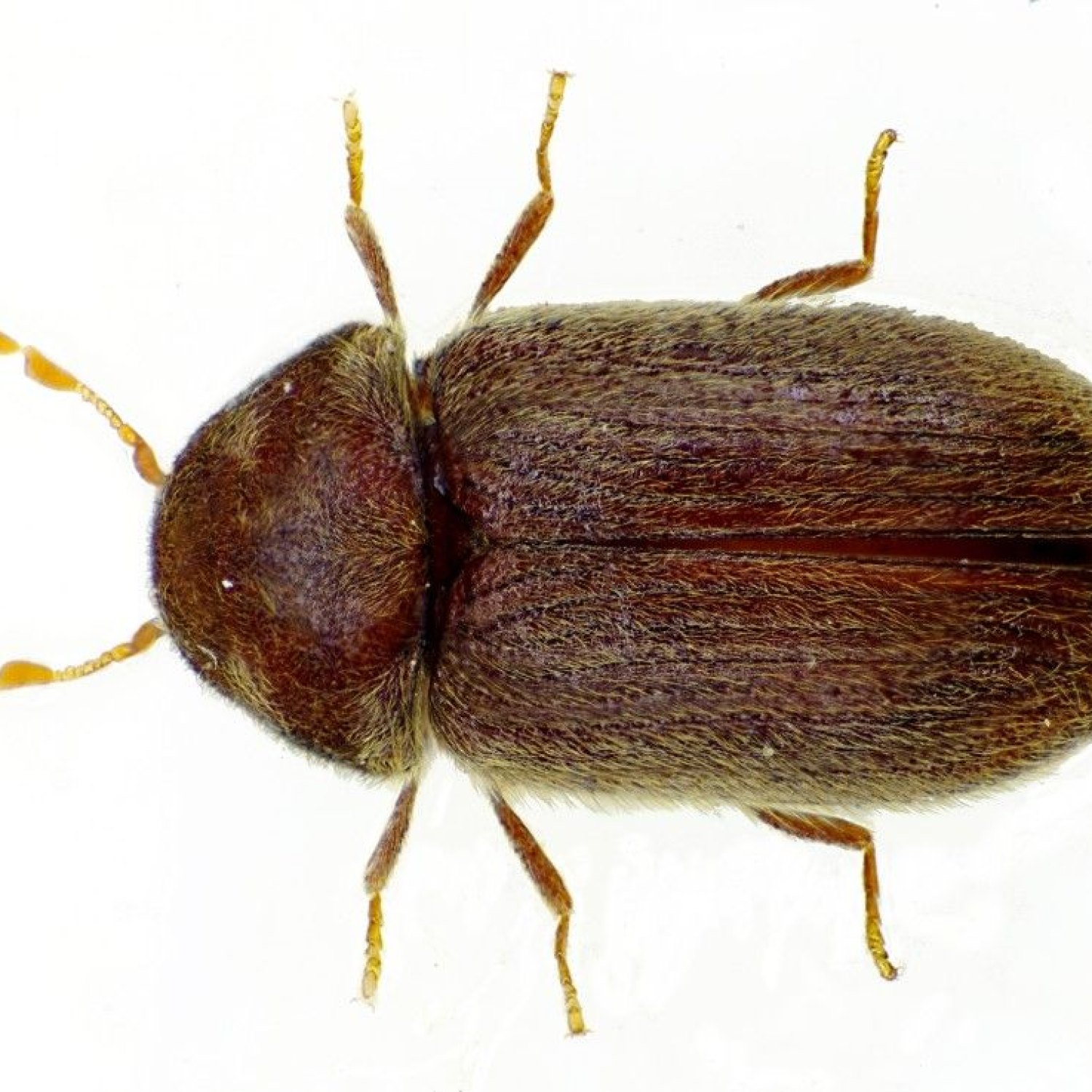
Carpet Beetle
Carpet Beetles typically measure between 1.5 to 4 mm in length.
Carpet Beetles are small but mighty creatures that can be found in various locations, from homes to museums, warehouses, and natural environments. They belong to the family Dermestidae and have an oval-shaped body with six legs and two pairs of wings. These tiny pests measure between 1.5 to 4 mm in length and are covered in tiny scales. Keep an eye out for these pesky insects and take necessary measures to prevent any damage they may cause. #CarpetBeetles #Insects #PestControl
Animal Details Summary:
Common Name: Carpet Beetle
Kingdom: Animalia
Habitat: Carpet Beetles can be found in a variety of habitats, including homes, museums, warehouses, and natural environments. They are commonly found in carpets, clothing, furniture, and stored products.
The Fascinating World of Carpet Beetles
Imagine waking up one day, stepping on your carpet, and suddenly realizing that it has small holes all over it. You check your clothes in the closet, only to find them full of tiny mysterious holes as well. What could have caused this damage? The culprit might just be one of the most underrated creatures on the planet - the carpet beetle.Carpet beetles, scientifically known as Anthrenus verbasci, might seem insignificant at first glance, but these tiny insects have a fascinating world and play an essential role in the environment Carpet Beetle. From their kingdom to their feeding habits, let's delve into the world of carpet beetles and discover some interesting facts about them.
A Family of Small But Mighty Creatures
Carpet beetles belong to the animal kingdom, phylum Arthropoda, and class Insecta. They are part of the order Coleoptera, which includes other well-known insects such as ladybugs and fireflies. However, carpet beetles belong to the family Dermestidae, which sets them apart from these insects. This family is also known as the skin beetles due to the insect's scavenging behavior - they feed on a wide variety of organic materials, including dead animals' skins.Where Can You Find Carpet Beetles?
Unlike other insects that are restricted to specific habitats, carpet beetles can be found almost anywhere - from homes to museums, warehouses, and even natural environments. They are known to thrive in areas where they can find food easily. Therefore, it's not surprising to find them in carpets, clothing, furniture, and stored products like grains and cereals.Carpet beetles are found worldwide, with different species having different distribution ranges Costas Hummingbird. They can be found in Europe, Asia, North and South America, Africa, and Australia. However, these tiny creatures are believed to be native to Europe, specifically Germany, and were later introduced to North America in the 19th century.
Unveiling the Colors and Shapes of Carpet Beetles
One of the most striking features of carpet beetles is their small size. They typically measure between 1.5 to 4 mm in length, making them almost invisible to the naked eye. But don't let their size fool you - carpet beetles come in a variety of colors and intriguing body shapes.Their body is covered in tiny scales that give them a mottled appearance. The colors of these scales can range from black and brown to yellow and white, and they often have a mixture of light and dark scales on their bodies. These scales not only give them their unique coloration but also help them in defense against predators.
In terms of body shape, carpet beetles have an oval-shaped body, which is a common characteristic among most insects. However, what sets them apart from other beetles is their distinct feature of having six legs and two pairs of wings. While their wings are fully developed in some species, others have reduced or even absent wings.
A Varied Diet for These Tiny Creatures
Much like their diverse habitats, carpet beetles have a varied diet as well. These insects are notorious for their feeding habits, as they can feed on a wide range of organic materials, making them a nuisance for homeowners and a threat to museums and warehouses.Carpet beetles feed on natural materials, including carpets, clothing, fur, feathers, and stored products such as grains and cereals. They are particularly attracted to materials that contain keratin, a protein found in animal hair, skin, and feathers. This is why they are often found in areas like closets, where clothes and furs may be stored.
Their feeding habits play an essential role in the environment as well. By consuming dead animal skins and feathers, they help in the natural process of decomposition, releasing nutrients back into the soil.
The Life Cycle of Carpet Beetles
Now that we have learned about the different characteristics of carpet beetles, let's take a look at their life cycle. Like most insects, carpet beetles have four stages in their life cycle - egg, larva, pupa, and adult. The duration of each stage can vary depending on the species, temperature, and climate.Eggs
Female carpet beetles lay eggs in the spring or summer, usually in dark, undisturbed areas where the larvae can quickly feed on natural materials. These eggs are white and oval in shape, measuring about 1 mm in length.Larva
The larvae are the most damaging stage of the carpet beetle's life cycle. They have an elongated and narrow body with a tuft of hair at the tail end. The hair gives them their other common name - "woolly bears." They can range in color from brown to light or dark stripes, depending on the species.Larvae go through several molting stages before reaching their full size, and during each stage, they actively feed on different organic materials. They also have the ability to digest keratin, which most other insects are unable to do.
Pupa
After the larvae have reached their full size, they will spin a cocoon, usually made of hairs and debris, where they enter the pupal stage. This stage can last from a few days to several weeks, depending on the temperature and humidity. During this time, they undergo metamorphosis, preparing to emerge as adults.Adult
After completing the pupal stage, adult carpet beetles will emerge in the spring or early summer. The duration of their adult life also depends on factors like temperature and food availability. The adults do not cause any damages, and they primarily spend their time searching for a mate to reproduce.Preventive Measures and Removal of Carpet Beetles
While carpet beetles may have a role in the environment, they can become a nuisance when they infest homes and cause damage to its contents. Unfortunately, it is challenging to completely eradicate carpet beetles, as they can enter homes from various sources, such as plants, furniture, or even through open windows.Here are a few preventative measures that can help in reducing the population of carpet beetles in and around your home:
- Clean your carpets and rugs regularly to remove any debris or food particles that may attract the beetles.
- Vacuum your clothes and closets, especially before storing seasonal clothes, to remove any eggs or larvae.
- Store fabrics and natural materials in airtight containers to prevent access to carpet beetles.
- Inspect plants before bringing them into your home, as they can be a source of carpet beetle infestation.
- Seal and caulk any cracks or openings in your home's exterior to prevent the entry of carpet beetles and other insects.
If you suspect an infestation, it's best to seek professional help to properly identify the type of carpet beetle and create a targeted plan for removal. Various effective methods, such as insecticides, heat treatment, and pheromone traps, can be used to eliminate carpet beetles from your home.
In Conclusion
From their diverse habitats and diet to their interesting colors and life cycle, carpet beetles truly are underrated creatures that play a crucial role in the environment. While they may cause damage to our homes and possessions, they are a reminder of the beauty and complexity of nature. So the next time you spot a tiny beetle scurrying across your carpet, take a moment to appreciate this small but mighty creature.

Carpet Beetle
Animal Details Carpet Beetle - Scientific Name: Anthrenus verbasci
- Category: Animals C
- Scientific Name: Anthrenus verbasci
- Common Name: Carpet Beetle
- Kingdom: Animalia
- Phylum: Arthropoda
- Class: Insecta
- Order: Coleoptera
- Family: Dermestidae
- Habitat: Carpet Beetles can be found in a variety of habitats, including homes, museums, warehouses, and natural environments. They are commonly found in carpets, clothing, furniture, and stored products.
- Feeding Method: Carpet Beetles feed on a wide range of organic materials, including carpets, clothing, fur, feathers, and stored products such as grains and cereals.
- Geographical Distribution: Carpet Beetles are found worldwide, with different species having different distribution ranges. They can be found in Europe, Asia, North and South America, Africa, and Australia.
- Country of Origin: Carpet Beetles are native to Europe and are believed to have been introduced to North America in the 19th century.
- Location: Carpet Beetles are found in various locations, including homes, museums, warehouses, and natural environments.
- Animal Coloration: Carpet Beetles are small insects with mottled patterns and colors that can range from black and brown to yellow and white. They often have a mixture of light and dark scales on their bodies.
- Body Shape: Carpet Beetles have an oval-shaped body that is covered in tiny scales. They have six legs and two pairs of wings, although the wings of some species are reduced or absent.
- Length: Carpet Beetles typically measure between 1.5 to 4 mm in length.
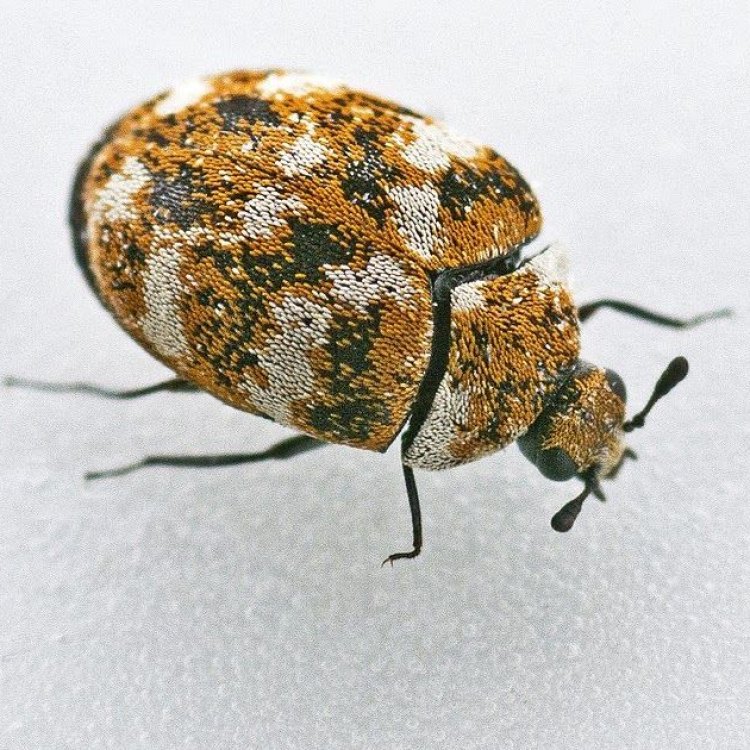
Carpet Beetle
- Adult Size: Adult Carpet Beetles are usually around 2 to 3 mm in length.
- Average Lifespan: The average lifespan of a Carpet Beetle can vary depending on the species and environmental conditions. In general, they can live for several months to a year or more.
- Reproduction: Carpet Beetles reproduce sexually, with males and females mating to produce offspring.
- Reproductive Behavior: After mating, female Carpet Beetles lay eggs in suitable locations, such as food sources or in the crevices of carpets, furniture, or clothing. The eggs hatch into larvae, which go through several molts before pupating and eventually emerging as adult beetles.
- Sound or Call: Carpet Beetles do not produce any sound or call.
- Migration Pattern: Carpet Beetles do not have a specific migration pattern. However, they may be inadvertently transported from one location to another through infested materials such as clothing or furniture.
- Social Groups: Carpet Beetles do not exhibit social behavior and are primarily solitary insects.
- Behavior: Carpet Beetles are generally nocturnal and are attracted to light sources. They are also known to be good fliers and can enter buildings through open windows or doors. They are attracted to materials that contain keratin, such as wool, fur, feathers, and certain types of fabric.
- Threats: Carpet Beetles are considered pests as they can cause damage to carpets, clothing, and other materials. Their larvae feed on natural fibers and can create holes or damage in these materials. They can also infest stored products, resulting in contamination and loss.
- Conservation Status: Carpet Beetles are not considered endangered or threatened species. They are common pests in many parts of the world.
- Impact on Ecosystem: Carpet Beetles play a role in the decomposition of organic materials. They also provide food for other organisms, such as birds and certain species of spiders.
- Human Use: Carpet Beetles are not used by humans for any specific purposes.
- Distinctive Features: Carpet Beetles have distinct mottled patterns and colors on their bodies. They also have a tiny, compact body with six legs and two pairs of wings (although wing size can vary among species).
- Interesting Facts: 1. Carpet Beetles are attracted to light and may be found near windows or light sources. 2. Their larvae are often mistaken for bed bugs due to their small size and similar appearance. 3. Carpet Beetles have the ability to digest keratin, a protein found in animal fibers such as wool and fur. 4. Certain species of Carpet Beetles are considered pests because their larvae can cause damage to textiles and stored products. 5. Some species of Carpet Beetles, such as the Varied Carpet Beetle, have specialized scales on their bodies that can cause skin irritation in some individuals.
- Predator: Carpet Beetles have various predators, including birds, spiders, and certain species of insects. Predatory beetles and wasps also feed on Carpet Beetle larvae.
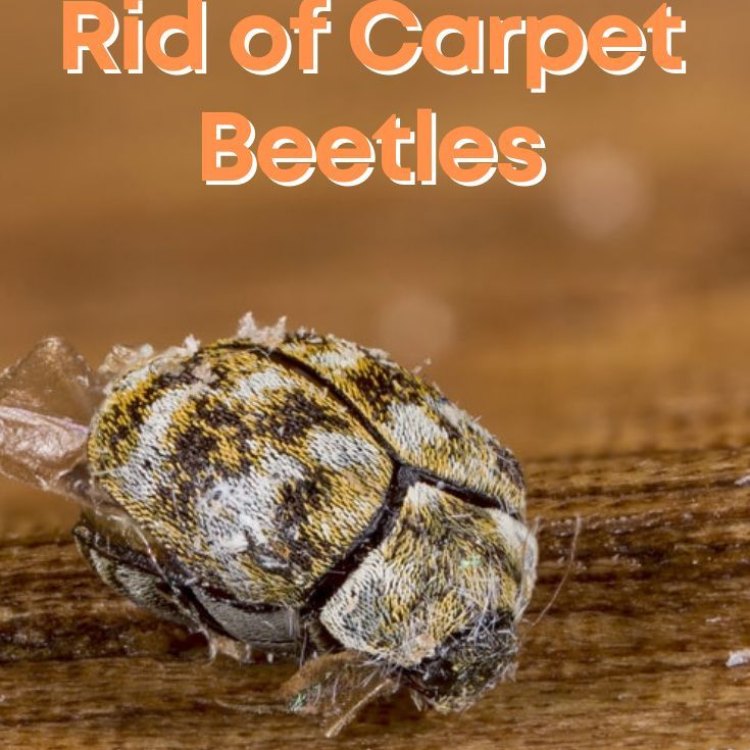
Anthrenus verbasci
The Fascinating World of Carpet Beetles
Carpet beetles may sound like a harmless and mundane insect, but these tiny creatures have a surprising and interesting role in our ecosystem. From their unique features to their impact on the environment, there is more to these little bugs than meets the eye.Appearance and Behavior
Adult Carpet Beetles are usually around 2 to 3 mm in length, making them almost invisible to the naked eye. They have a compact body with six legs and two pairs of wings, with varying sizes among different species PeaceOfAnimals.Com. Despite their small size, they are powerful flyers and are known to enter buildings through open windows or doors.
Carpet Beetles are primarily nocturnal and are attracted to light sources. You may have noticed them near windows or light fixtures at night. They are also attracted to materials that contain keratin, such as wool, fur, feathers, and even certain types of fabric. This is because they have the ability to digest keratin, a protein found in animal fibers. This unique trait plays a significant role in their survival and behavior.
Reproduction and Lifecycle
Carpet Beetles reproduce sexually, with males and females mating to produce offspring. After mating, female Carpet Beetles lay eggs in suitable locations, such as food sources or in the crevices of carpets, furniture, or clothing. The eggs hatch into larvae, which go through several molts before pupating and eventually emerging as adult beetles Cockroach.
The larvae of Carpet Beetles are often mistaken for bed bugs due to their small size and similar appearance. However, they pose a different kind of threat, as they feed on natural fibers and can cause damage to carpets, clothing, and other materials. It is important to take immediate action if you discover Carpet Beetle larvae infesting your home.
Impact on the Ecosystem
Carpet Beetles play a crucial role in the ecosystem by aiding in the decomposition of organic materials. They also serve as a food source for other organisms, such as birds and certain species of spiders. However, they also have a negative impact on the environment, as their feeding habits can damage and destroy natural fibers.
Threats and Conservation Status
Although Carpet Beetles may seem harmless, they are considered pests in many parts of the world. Their larvae can cause significant damage to carpets, clothing, and stored products, resulting in contamination and loss. As a result, they are often considered a threat to household items and economic stability.
However, it is important to note that Carpet Beetles are not classified as endangered or threatened species. They are common pests in many regions and are not actively conserved or protected. This is due to their resilient nature and ability to thrive in various environments.
Interesting Facts
Here are a few more interesting facts about Carpet Beetles:
1. Tingling Near Your Windows? It could be Carpet Beetles!
As mentioned earlier, Carpet Beetles are attracted to light. This makes them commonly found near windows or light fixtures at night. If you feel a slight tingling sensation near your windows, it could be these tiny creatures flying around.
2. Don't Mistake Carpet Beetle Larvae for Bed Bugs
The small size and similar appearance of Carpet Beetle larvae often cause them to be mistaken for bed bugs. However, the two have very different feeding habits and require different methods of elimination.
3. Keratin Digesting Capability
Carpet Beetles have evolved to have the ability to digest keratin, a protein found in animal fibers such as wool and fur. This allows them to survive and thrive in various environments.
4. Pests in Some Parts of the World
While Carpet Beetles are not considered pests in most parts of the world, certain species, such as the Varied Carpet Beetle, can cause significant damage to textiles and stored products.
5. Some Species Can Cause Skin Irritation
The scales on the bodies of some species of Carpet Beetles, such as the Varied Carpet Beetle, can cause irritation and allergic reactions in some individuals. This is another reason why it is important to take action if you discover an infestation in your home.
Predators of Carpet Beetles
Just like any other insect, Carpet Beetles have predators in their natural habitat. Birds, spiders, and certain species of insects feed on these tiny creatures in the wild. Predatory beetles and wasps also play a significant role in controlling Carpet Beetle populations.
In the end, Carpet Beetles may seem like a small and insignificant part of our ecosystem, but they have a unique and essential role to play. From aiding in decomposition to providing food for other organisms and even causing damage to household items, these tiny creatures have an impact on our environment. While we may not appreciate their presence in our homes, it is important to remember their value as a part of our ecosystem.

The Fascinating World of Carpet Beetles
Disclaimer: The content provided is for informational purposes only. We cannot guarantee the accuracy of the information on this page 100%. All information provided here may change without prior notice.


